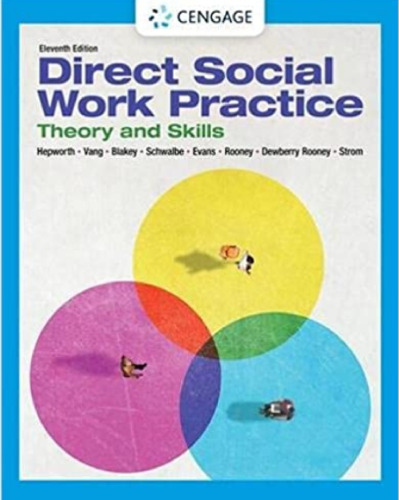Description
Direct Social Work Practice: Theory and Skills 11th Edition by Dean Hepworth, ISBN-13: 978-0357630594
[PDF eBook eTextbook] – Available Instantly
- Publisher: Cengage Learning; 11th edition (January 1, 2022)
- Language: English
- 450 pages
- ISBN-10: 0357630599
- ISBN-13: 978-0357630594
Considered the profession’s ideal learning resource, DIRECT SOCIAL WORK PRACTICE: THEORY AND SKILLS, Eleventh Edition, prepares you for effective real-world practice. Packed with case examples, illustrations and relevant learning experiences from the authors and other social work practitioners, the text integrates the major theories and skills needed for contemporary direct social work practice. Part of the Brooks/Cole Empowerment Series, the Eleventh Edition is completely up to date, exploring evolving ethical and practice challenges, the impact of COVID-19, implications of electronic service delivery, social injustice, Black Lives Matter and other issues related to racial inequity. In addition, the authors have carefully revised the text to incorporate gender-neutral language and explore key structural implications affecting clients and practice. The text thoroughly integrates the core competencies and recommended practice behaviors outlined in the 2015 Educational Policy and Accreditation Standards (EPAS) set by the Council on Social Work Education (CSWE). As you’re preparing to practice social work in today’s complex world, this trusted text is an ideal resource to equip you for exam and career success.
Table of Contents:
Cover Page
Title Page
Copyright Page
Preface
Acknowledgments
About the Authors
Part 1. Introduction
Chapter 1. The Challenges and Opportunities of Social Work
The Mission of Social Work
Direct Social Work Practice
Roles
Social Work Values
Social Work Competencies
EPAS Competency 1—Demonstrate Ethical and Professional Behavior
EPAS Competency 2—Engage Anti-Racism, Diversity, Equity, and Inclusion in Practice
EPAS Competency 3—Advance Human Rights, and Social, Racial, Economic, and Environmental Justice
EPAS Competency 4—Engage in Practice-Informed Research and Research-Informed Practice
EPAS Competency 5—Engage in Policy Practice
EPAS Competency 6—Engage with Individuals, Families, Groups, Organizations, and Communities
EPAS Competency 7—Assess Individuals, Families, Groups, Organizations, and Communities
EPAS Competency 8—Intervene with Individuals, Families, Groups, Organizations, and Communities
EPAS Competency 9—Evaluate Practice with Individuals, Families, Groups, Organizations, and Communities
Contemporary Influences on Direct Practice
Self-Care
Pandemics
Funding for Services
Technological Advances
Globalization
Scientific Changes
Sociopolitical Environment
Applying the Concepts to the Ramirez Case
Summary
Competency Notes
Chapter 2. Orienting Frameworks for Social Work Practice
Philosophies of Practice
Orienting Perspectives
Ecosystems Perspective
Principles of the Ecosystems Perspective
Critiques of the Ecosystems Perspective
Application of the Ecosystems Perspective
Strengths Perspective
Principles of the Strengths Perspective
Critiques of the Strengths Perspective
Application of the Strengths Perspective
Cultural Humility
Principles of Cultural Humility
Critiques of Cultural Humility
Application of Cultural Humility
Anti-Oppressive Social Work
Principles of Anti-Oppressive Social Work
Critiques of Anti-Oppressive Social Work
Application of Anti-Oppressive Social Work
Trauma-Informed Social Work
Principles of Trauma-Informed Social Work
Critiques of Trauma-Informed Social Work
Application of Trauma-Informed Social Work
Evidence-Informed Social Work Practice
Principles of Evidence-Informed Social Work
Critiques of Evidence-Informed Social Work
Application of Evidence-Informed Social Work
Principles for Practice
Summary
Competency Notes
Chapter 3. Overview of the Helping Process
The Helping Process
Physical Conditions
Phase I: Exploration, Engagement, Assessment, and Planning
Problem Exploration
Exploring Expectations
Establishing Rapport and Enhancing Motivation
How to Establish Rapport
Structure of Interviews
Starting Where the Client Is
Furthering Responses, Paraphrasing, and Feedback
Focusing in Depth
Formulating a Multidimensional Assessment of the Problem, Identifying Systems, and Identifying Relevant Resources
Eliciting Essential Information
Exploring Cognitive Functioning
Exploring Suicidal Risk, Substance Abuse, Violence, and Sexual Abuse
Mutually Negotiating Goals and Formulating a Contract
Making Referrals
Phase II: Implementation and Goal Attainment
Enhancing Self-Efficacy
Monitoring Progress
Barriers to Goal Accomplishment
Relational Reactions
Enhancing Clients’ Self-Awareness
Use of Self
Phase III: Termination
Successfully Terminating Helping Relationships
Planning Change Maintenance Strategies
Evaluate Results
Summary
Competency Notes
Note
Chapter 4. Operationalizing Social Work Values and Ethics
The Interaction Between Personal and Professional Values
The Cardinal Values of Social Work
Service
Social Justice
Dignity and Worth
Human Relationships
Integrity
Competence
Valuing Service
Valuing Social Justice
Valuing the Person’s Dignity and Worth
Valuing Human Relationships
Valuing Integrity
Valuing Competence
Challenges in Embracing the Profession’s Values
Ethics
The Intersection of Laws and Ethics
Key Ethical Principles
Self-Determination
Providing Informed Consent
Preserving Professional Boundaries
Safeguarding Confidentiality
What Are the Limits on Confidentiality?
Supervision and Consultation
Client Waivers of Confidentiality
Danger to Self or Others
Suspicion of Child or Elder Abuse
Subpoenas and Privileged Communication
Confidentiality in Various Types of Recording
The Ethics of Practice with Minors
Understanding and Resolving Ethical Dilemmas
Steps in Ethical Decision-Making
Applying the Ethical Decision-Making Model
Options for Action
To Tell or Not to Tell
Summary
Competency Notes
Skill Development Exercises
Skill Development Exercises
Part 2. Exploring, Assessing, and Planning
Chapter 5. Building Blocks of Communication: Conveying Empathy and Authenticity
Roles of the Participants
Determine Your Client’s Expectations for the Helping Process
Discuss the Helping Process
Communicating Informed Consent, Confidentiality, and Agency Policies
Facilitative Conditions
Empathic Communication
Developing Perceptiveness to Feelings
Affective Words and Phrases
Using the Lists of Affective Words and Phrases
Client Statements
Accurately Conveying Empathy
Surface Empathy
Reciprocal Empathy
Additive Empathy
Responding with Reciprocal Empathy
Constructing Reciprocal Responses
Leads for Empathic Responses
Employing Empathic Responding
Multiple Uses of Empathic Communication
Authenticity
Types of Authentic Responses
A Paradigm for Self-Involving Statements
Cues for Authentic Responding
Summary
Competency Notes
Skill Development Exercises
Client Statements
Modeled Social Worker Responses
Chapter 6. Verbal Following, Exploring, and Focusing Skills
Verbal Following Skills
Furthering Responses
Reflection Responses
Forms of Reflections
Contingent Reflective Listening
Exercises in Reflective Listening
Closed- and Open-Ended Questions
Formulating Open-Ended Questions
Exercises in Identifying Closed- and Open-Ended Responses
Summarizing Responses
Highlighting Problems, Strengths, and Resources
Clarify Lengthy Messages
Facilitating Transitions
Seeking Concreteness
Check Perceptions
Clarify Vague or Unfamiliar Terms
Elicit Specific Feelings
Focus on the Here and Now
Elicit Sequence of Events
Specificity of Expression by Social Workers
Exercises in Seeking Concreteness
Client Statements
Maintaining Focus
Selecting Topics for Exploration
Exploring Topics in Depth
Open-Ended Responses
Reflective Listening
Blending Open-ended Questions with Reflections
Managing Obstacles to Focusing
Analyzing Your Verbal Following Skills
Summary
Competency Notes
Exercises in Reflective Listening
Exercises in Closed- and Open-Ended Responses
Exercises in Seeking Concreteness
Chapter 7. Eliminating Counterproductive Communication Patterns and Substituting Positive Alternatives
Impacts of Counterproductive Communication Patterns
Identifying and Improving Nonverbal Barriers to Effective Communication
Physical Attending
Taking Inventory of Nonverbal Patterns of Responding
Eliminating Verbal Barriers to Communication
Social Worker Verbal Behavior Contributing to Communication Barriers
Inappropriate Interviewing Technique Barriers
Gauging the Effectiveness of Your Responses
The Challenge of Learning New Skills
Summary
Competency Notes
Chapter 8. Assessment: Exploring and Understanding Problems and Strengths
The Multidimensionality of Assessment
Defining Assessment: Product and Process
Assessment Focus
Assessment and Diagnosis
The Diagnostic and Statistical Manual (DSM-5)
Sources of Information for Assessments
Information Provided by the Client
Collateral Contacts
Assessment Instruments
Social Worker’s Personal Experience with the Client
Areas of Focus in Assessments
Priorities in Assessments
Identifying the Presenting Problem
Severity of the Problem
Meanings that Clients Ascribe to Problems
Sites of Presenting Problems
Temporal Context of Presenting Problems
Frequency of Presenting Problems
Duration of the Problem
Assessing Strengths
The Interaction of Other People or Systems
Assessing Needs and Wants
Stresses Associated with Life Transitions
Cultural, Societal, and Social Class Factors
Other Issues Affecting Client Functioning
Emotional Reactions
Coping Efforts and Needed Skills
Support Systems
Resources Needed
Assessing Children and Older Adults
Data Sources and Interviewing Techniques
Assessment Techniques Specific to Children and Adolescents
Assessment Techniques Specific to Older Adults
Maltreatment
The Role of Knowledge and Theory in Assessments
Theories
Caveats about Using Knowledge and Theories
Telesocial Work
Summary
Competency Notes
Skill Development Exercises
Note
Chapter 9. Assessing Individual and Environmental Factors and Their Interaction
The Interaction of Multiple Systems in Human Problems
Implicit Bias
Assessing Biophysical Functioning
Physical Characteristics and Presentation
Physical Health
Assessing Use and Abuse of Medications, Alcohol, and Drugs
Alcohol Use and Abuse
Use and Abuse of Other Substances
Dual Diagnosis: Addiction and Mental Health Disorders
Assessing Cognitive/ Perceptual Functioning
Intellectual Functioning
Judgment
Reality Testing
Coherence
Cognitive Flexibility
Values
Beliefs
Self-Concept
Assessing Affective Functioning
Emotional Control and Range of Emotions
Appropriateness of Affect
Suicidal Risk
Depression and Suicidal Risk with Children and Adolescents
Depression and Suicidal Risk with Older Adults
Assessing Behavioral Functioning
Risk of Aggression
Motivation
Assessing Environmental Systems
Physical Environment
Social Support Systems
Spirituality and Affiliation with a Faith Community
Written Assessments
Biopsychosocial Assessments
Case Notes
Summary
Competency Notes
Chapter 10. Assessing Family Functioning in Diverse Family and Cultural Contexts
Defining Family and Family Functions
Self-Awareness in Family Assessment
The Family Systems Framework
Homeostasis
Boundaries and Boundary Maintenance
External Family Boundaries
Internal Boundaries and Family Subsystems
Enmeshment and Disengagement
Family Decision-Making, Hierarchy, and Power
Family Roles
Communication Patterns in Families
Congruence and Clarity of Communication
Barriers to Communication
Receiver Skills
Sender Skills
Family Life Cycle
Family Rules
Explicit and Implicit Rules
Flexible and Rigid Rules
Social Environment
Family Adaptive Capacity
Family Stressors
Family Strengths and Resilience
Assessment Skills and Strategies
Observing Patterns of Interaction
Interviewing Skills and Circular Questioning
Genograms
Standardized Scales
Summary
Competency Notes
Skill Development Exercises
Chapter 11. Understanding Social Work Groups
Classification of Groups
Group Subtypes
Treatment Groups Subtypes
Self-Help Group Subtypes
Task Group Subtypes
Developing Treatment Groups
Identifying the Need for the Group
Establishing the Group Purpose
Individual or Co-Leadership
Determining Group Composition
Choosing an Open or Closed Group
Determining Group Size and Location
Setting the Frequency and Duration of Meetings
Conducting Preliminary Interviews
Planning Group Sessions
Formulating Preliminary Group Guidelines
Help-Giving/Help-Seeking Roles
New Members
Individual Contacts with the Social Worker
Member Contacts Outside the Group
Use of Recording Devices and Phones
Eating and Drinking
Profanity
Attendance
Touching
Assessing Group Processes
A Systems Framework for Assessing Groups
Assessing Individuals’ Patterned Behaviors
Identifying Roles of Group Members
Assessing the Group’s Patterned Behaviors
Assessing Group Alliances
Assessing Group Norms
Assessing Group Cohesion
Self-Help Groups
Task Groups
Task Group Purpose
Task Group Membership and Planning
Beginning the Task Group
Summary
Competency Notes
Skill Development Exercises
Chapter 12. Developing Goals and Formulating a Contract
Goals
Purpose of Goals in Direct Social Work
Types of Goals
Factors Influencing Goal Formation
Guidelines for Selecting and Defining Goals
Guidelines for Selecting and Defining Goals with Minors
The Process of Formulating Goals
Determine Clients’ Readiness for Goal Formulation
Explain the Purpose and Function of Goals
Formulate Client-Driven Goals
Defining Client-Driven Goals with Mandated Clients
Increase Goal Specificity
Determine Potential Barriers and Benefits
Rank Goals According to Client Priorities
Monitoring Progress and Evaluation
Quantitative Measurements
Measuring Observable Behaviors
Retrospective Estimates of Baseline Behaviors
Self-Anchored Scales
Guidelines for Obtaining Baseline Measures
Monitoring Progress
Receptivity of Clients to Measurement
Qualitative Measurements
Informative Events or Critical Incidences
Combining Methods for Measuring and Evaluating
Evaluating Your Practice
Contracts
The Rationale for Contracts
Formal and Informal Contracts
Developing Contracts
Goals to Be Accomplished
Roles of Participants
Interventions or Techniques to Be Employed
Time Frame, Frequency, and Length of Sessions
Means of Monitoring Progress
Stipulations for Renegotiating the Contract
Housekeeping Items
Sample Contracts
Summary
Competency Notes
Skill Development Exercises
Notes
Part 3. The Change-Oriented Phase
Chapter 13. Choosing and Implementing Interventions to Facilitate Change
Interventions to Facilitate Change
Person-in-Environment
Change Happens through the Helping Relationship
Strengths Perspective
Empowerment
Choosing an Intervention or Approach
Evidence-Based, Evidence-Informed, Empirically Supported Treatments, and Practice Wisdom
Different Types of Interventions
The Task-Centered Model
Tenets of the Task-Centered Approach
Application of the Task-Centered Model
Procedures of the Task-Centered Model
Goal Development and Partializing Goals
General Tasks
Specific Tasks
Assess Client Readiness to Engage in an Agreed-Upon Task
Plan the Details of Carrying Out Tasks
Analyze and Resolve Barriers and Obstacles
Identify Rewards or Incentives
Rehearse or Practice Behaviors Involved in Tasks
Summarizing the Task Plan and Monitor Progress
Failure to Complete Tasks
Reasons Related to Not Completing a Specific Task
Strengths and Limitations of the Task-Centered Model
The Crisis Intervention Model
Tenets of the Crisis Intervention Model
Intervene Quickly
Stability Is Paramount
Listen to Understand
Problem Solving Is Critical
Restore Independent Functioning
Procedures of the Crisis Intervention Model
Application of the Crisis Intervention Model
Anticipatory Guidance
Strengths and Limitations of Crisis Intervention
Solution-Focused Brief Treatment Model
Tenets of the Solution-Focused Brief Treatment Model
Solution-Focused Brief Treatment Language and Techniques
Application of the Solution-Focused Approach
Phase 1: Engagement (Description of the Problem)
Phase 2: Assessment (Developing Well-Formed Goals)
Phase 3: Goal Setting (Exploring Exceptions)
Phase 4: Intervention (End-of-Session Feedback)
Phase 5: Termination (Evaluating Progress)
From Session to Session
Strengths and Limitations of the Solution-Focused Approach
Case Management
Tenets of Case Management
Case Management Phases
Case Example
Phase 1: Intake and Screening
Phase 2: Assessment
Phase 3: Stratifying Risk
Phase 4: The Planning Phase
Phase 5: The Implementing (Case Coordination) Phase
Phase 6: The Follow-up Phase
Phase 7: The Transitioning (Transitional Care) Phase
Phase 8: Communicating Post-transition Phase
Phase 9: The Evaluation Phase
Strengths and Limitations of Case Management
Motivational Interviewing
MI Spirit—The Style of Motivational Interviewing
Collaboration/Partnership
Acceptance
Compassion
Evocation
MI and Social Work
MI Technical Skills
Use of Open-ended Questions
Affirmation
Reflective Listening
Summarizing
Change Talk Versus Sustain Talk
MI with Involuntary Clients
Ambivalence Regarding Change
Cognitive Behavioral Therapeutic Approach
Tenets of Cognitive Behavioral Therapy
Helpful and Unhelpful Thought Patterns
Strengths and Limitations of CBT
Trauma-Informed Care: An Overview of Concepts, Principles, and Resources
Tenets of Trauma-Informed Care
Safety
Connection
Emotional Regulation and Coping Skills
Theoretical Framework
Phases of Trauma-Informed Care
Trauma-Specific Treatment
Strengths and Limitations of Trauma-Informed Care
Mind–Body Interventions
Example 1: Grounding
Example 2: Mindfulness
Strengths and Limitations of Mind–Body Interventions
Summary
Competency Notes
Skill Development Exercises
Chapter 14. Balancing Micro and Macro Social Work Practice: Roles, Theories, and Intervention Strategies
Defining Macro Practice
Macro-Level Practice Skills
Macro-Level Social Work Roles
The Link Between Micro and Macro Practice
What Micro and Macro Practice Have in Common
Macro-Level Theories
Other Factors Affecting Macro Practice
Structural Racism
Institutional Racism
Interconnectedness of Structural and Institutional Racism
Historical Trauma
Historical Trauma and Macro Practice
Social Justice
Social Justice Is an Ideal Aspiration
Who Decides What Is Socially Just?
Macro Practice Is a Vehicle for Social Justice
Social Justice: Micro Responses and Macro-Level Solutions
The Helping Process
Types of Macro Social Work Practice
Community Organizing
Tasks Related to Community Organizing
Organizational Change
Tasks Related to Organizational Change
Policy Development
Tasks Related to Policy Development
Phase I: Exploration, Engagement, Assessment, and Planning
Stage 1: Exploration
Community Organizing
Organizational Change
Policy Development
Stage 2: Engagement
Community Organizing
Organizational Change
Policy Development
Stage 3: Assessment
Community Organizing
Organizational Change
Policy Development
Stage 4: Planning
Community Organizing
Organizational Change
Policy Development
Phase II: Implementation and Goal Attainment
Stage 1: Implementation
Community Organizing
Organizational Change
Policy Development
Stage 2: Goal Attainment
Community Organizing
Organizational Change
Policy Development
Phase III: Termination
Community Organizing
Organizational Change
Policy Development
Social Media as a Resource for Macro Practice
Summary
Competency Notes
Chapter 15. Enhancing Family Functioning and Relationships
Family Engagement
Joining
Cultural Perspectives on Engagement
Differences in Communication Styles
Hierarchical Considerations in Communication
Authority of the Social Worker
Preventing Alliances
The Dynamics of Minority Status and Culture in Exploring Reservations
Orchestrating the Initial Family or Couple Session
Establish a Personal Relationship with Individual Members and an Alliance with the Family as a Group
Clarify Expectations and Explore Reservations about the Helping Process
Clarify Roles and the Nature of the Helping Process
Clarify Choices about Participation in the Helping Process
Elicit the Family’s Perception of the Problem
Identify Wants and Needs of Family Members
Define the Problem as a Family Problem
Emphasize Individual and Family Strengths
Establish Individual and Family Goals Based on Your Earlier Exploration of Wants and Needs
Family Interventions
First-Order Change Strategies
Problem-Solving Approaches
Skills Training
Contingency Contracting
Second-Order Change Strategies
Modifying Misconceptions and Cognitive Distortions
Modifying Communication Patterns
Giving and Receiving Feedback
Assessing Positive and Negative Feedback
Teaching Positive Feedback
Modifying Family Rules
To the Father
To Other Family Members
Modifying Family Alignments and Hierarchy
Structural Mapping
Family Sculpting
Joined Families
On-the-Spot Interventions
Focus on Process Rather Than Content
Give Feedback That Is Descriptive and Neutral Rather Than General or Evaluative
Balance Interventions to Divide Responsibility
Redirect Hostile, Blaming Messages
Assisting Families to Disengage from Conflict
Summary
Competency Notes
Skill Development Exercises
Chapter 16. Facilitating Social Work Groups
Stages of Group Development
Stage 1. Preaffiliation: Approach and Avoidance Behavior
Stage 2. Power and Control: A Time of Transition
Stage 3. Intimacy: Developing a Familial Frame of Reference
Stage 4. Differentiation: Developing Group Identity and an Internal Frame of Reference
Stage 5. Separation: Breaking Away
The Facilitator’s Role and Activities
Stage-Specific Interventions
Interventions in the Preaffiliation Stage
Interventions in the Power and Control Stage
Minimize Changes
Encourage Balanced Feedback
Increase Effective Communication
Influence Constructive Norms
Interventions in the Intimacy and Differentiation Stages
Interventions in the Termination Stage
Interventions with Task Groups
Interventions in the Preaffiliation Stage
Interventions in the Power and Control Stage
Interventions in the Working Phase Stage
Interventions at the Termination Stage
Summary
Competency Notes
Skill Development Exercises
Client Statements
Modeled Social Worker
Note
Chapter 17. Additive Empathy, Interpretation, and Confrontation
The EPAS Competencies
The Meaning and Significance of Self-Awareness
Additive Empathy and Interpretation
Deeper Feelings
Underlying Meanings of Feelings, Thoughts, and Behaviors
Wants and Goals
Hidden Purposes of Behavior
Challenging Beliefs Stated as Facts
Unrealized Strengths and Potentialities
Guidelines for Employing Interpretation and Additive Empathy
Confrontation
Self-Confrontation
Assertive Confrontation
Guidelines for Employing Confrontation
Indications for Assertive Confrontation
Cognitive/Perceptual Discrepancies
Affective Discrepancies
Behavioral Discrepancies
Summary
Competency Notes
Skill Development Exercises
Skill Development Exercises
Note
Chapter 18. Managing Barriers to Change
Barriers to Change
Relational Dynamics
The Importance of Reciprocal Positive Feelings
Steps to Take to Reduce the Risk of Negative Relational Dynamics
Under- and Overinvolvement of Social Workers with Clients
Burnout, Compassion Fatigue, and Vicarious Trauma
Assessing Potential Barriers and Intervening in Interactions with Clients
Problematic Social Worker Behavior
Cross-Racial and Cross-Cultural Experience Barriers and Broaching
Employing Broaching Skills
Difficulties in Establishing Trust
Transference Reactions
Identifying Transference Reactions
Managing Transference Reactions
Countertransference Reactions
Managing Countertransference Reactions
Realistic Social Worker Reactions
Sexual Attraction toward Clients
Motivating Change
Dealing with Reactance
Reactance Theory
Change Strategies
Motivational Interviewing and Addressing Barriers to Change
Positive Connotation
Redefining Problems as Opportunities for Growth
Therapeutic Binds
Summary
Competency Notes
Skill Development Exercises
Skill Development Exercises
Part 4. The Termination Phase
Chapter 19. The Final Phase: Evaluation and Termination
Evaluation
Outcomes
Process
Satisfaction
Hybrid Models
Termination
Types of Termination
Unplanned Terminations
Managing Unplanned Terminations
Planned Terminations with Unsuccessful Outcomes
Planned Terminations with Successful Outcomes
Termination Due to Temporal, Structural, or Financial Limits
Other Determinants of Planned Termination
Understanding and Responding to Clients’ Termination Reactions
Anger
Denial
Avoidance
Reporting Recurrence of Old Problems or Generating New Ones
Attempting to Prolong Contact
Social Workers’ Reactions to Termination
Consolidating Gains and Planning Maintenance Strategies
Follow-Up Sessions
Ending Rituals
Summary
Competency Notes
Skill Development Exercises
Notes
Media Index
Chapter 1. The Challenges and Opportunities of Social Work
Chapter 3. Overview of the Helping Process
Chapter 4. Operationalizing Social Work Values and Ethics
Chapter 5. Building Blocks of Communication: Conveying Empathy and Authenticity
Chapter 6. Verbal Following, Exploring, and Focusing Skills
Chapter 7. Eliminating Counterproductive Communication Patterns and Substituting Positive Alternatives
Chapter 8. Assessment: Exploring and Understanding Problems and Strengths
Chapter 9. Assessing Individual and Environmental Factors and Their Interaction
Chapter 10. Assessing Family Functioning in Diverse Family and Cultural Contexts
Chapter 12. Developing Goals and Formulating a Contract
Chapter 13. Choosing and Implementing Interventions to Facilitate Change
Chapter 15. Enhancing Family Functioning and Relationships
Chapter 17. Additive Empathy, Interpretation, and Confrontation
Chapter 18. Managing Barriers to Change
Chapter 19. The Final Phase: Evaluation and Termination
Bibliography
Dean Hepworth, MSW, PhD, is Professor Emeritus at the School of Social Work, Arizona State University, Tempe Arizona, and the University of Utah. Dean has extensive practice experience in individual psychotherapy and marriage and family therapy. Dean was the lead author and active in the production of the first four editions, and he is the coauthor of Improving Therapeutic Communication. He is now retired and lives in Phoenix, Arizona.
What makes us different?
• Instant Download
• Always Competitive Pricing
• 100% Privacy
• FREE Sample Available
• 24-7 LIVE Customer Support






